
The steam locomotives of British Railways were used by British Railways over the period 1948–1968. The vast majority of these were inherited from its four constituent companies, the "Big Four".

The BR Standard Class 8 was a class of a single 4-6-2 Pacific steam locomotive designed by Robert Riddles for use by British Railways. Only the prototype was constructed, named Duke of Gloucester. Constructed at Crewe Works in 1954, the Duke, as it is popularly known, was a replacement for the destroyed LMS Princess Royal Class locomotive number 46202 Princess Anne, which was involved in the Harrow and Wealdstone rail crash of 1952.

Woodham Brothers Ltd is a trading business, based mainly around activities and premises located within Barry Docks, in Barry, South Wales. It is noted globally for its 1960s activity as a scrapyard, where 297 withdrawn British Railways steam locomotives were sent, from which 213 were rescued for the developing railway preservation movement.

The British Railways Standard Class 4 4-6-0 is a class of steam locomotives, 80 of which were built during the 1950s. Six have been preserved.
The BR Standard steam locomotives were an effort to standardize locomotives from the motley collection of older pre-grouping locos. Construction started in 1951. Due to the controversial British Railways' modernisation plan of 1955, where steam traction was abandoned in favour of diesel and electric traction, many of the locomotives' working lives were very short: between 7 and 17 years. Many have been preserved, mainly due to their having been sent to Barry Scrapyard.

The BR Standard Class 4 2-6-0 is a class of steam locomotive designed by Robert Riddles for British Railways (BR). 115 locomotives were built to this standard.
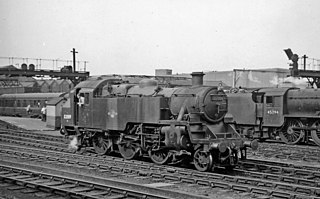
The BR Standard Class 3 2-6-2T was a class of steam locomotive designed by Robert Riddles for British Railways. It was essentially a hybrid design, the chassis being closely based on and sharing a number of parts with the LMS Ivatt Class 4, and having a boiler derived from a GWR No.2 boiler as fitted to the GWR Large Prairie 2-6-2T and 5600 Class 0-6-2T tank engines.

The BR Standard Class 2 2-6-0 is a class of steam locomotive, one of the British Railways Standard classes of the 1950s. They were physically the smallest of the Standard classes; 65 were built.
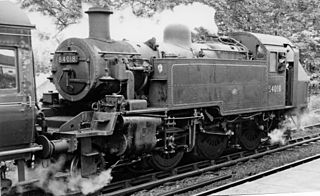
The British Railways standard class 2 2-6-2T was a class of steam locomotive, one of the standard classes of the 1950s.
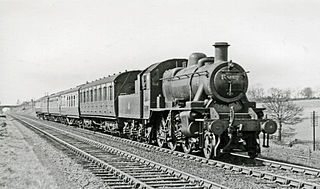
The London, Midland and Scottish Railway (LMS) Ivatt Class 2 2-6-0 is a class of steam locomotive designed for light mixed traffic.

The Barry Tourist Railway is a railway developed to attract visitors to Barry in the Vale of Glamorgan, South Wales. It is a key element of the Barry Rail Centre which also includes engineering and training facilities.
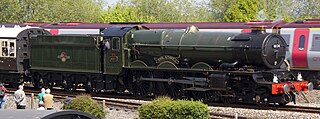
6024 King Edward I is a preserved Great Western Railway (GWR) 6000 Class steam locomotive operated from 1930 to 1962 by the Great Western Railway and latterly British Railways hauling express passenger services.

GWR 4073 Class 5080 Defiant is a GWR 4073 Class steam locomotive built for the Great Western Railway at Swindon Works in May 1939. It was originally named Ogmore Castle.

35027 Port Line was one of a batch of ten SR Merchant Navy class steam locomotives built by the Southern Region of British Railways between 1948 and 1949.
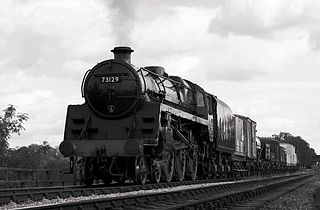
British Railways Standard Class 5 No. 73129 is a preserved British steam locomotive. It is the only surviving Standard Class 5 built by British Railways which was fitted with Caprotti valve gear.
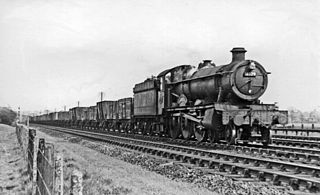
GWR 4900 Class 4-6-0 No. 4979 Wootton Hall is a steam locomotive. It was built at Swindon, February 1930, and was one of 258 Hall class steam locomotives constructed.

British Railways Standard Class 5 No. 73096 is a preserved British steam locomotive, unnamed in service. It has spent most of its time in preservation in the care of the Watercress Line.
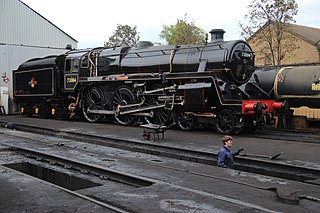
British Railways Standard Class 5 No. 73156 is a preserved British steam locomotive. Its restoration at Loughborough on the Great Central Railway was completed in 2017, and it made its formal debut on 5 October 2017 in the guise of 73084 Tintagel. 73156 is the sole surviving BR Standard locomotive built at Doncaster Works. It had been allocated to two GCR sheds

21C153 Sir Keith Park is a Southern Railway Battle of Britain class 4-6-2 Pacific steam locomotive that has been preserved. It became a permanent resident at the Spa Valley Railway in September 2020, where it was operational until the expiry of its boiler ticket in May 2022.


















